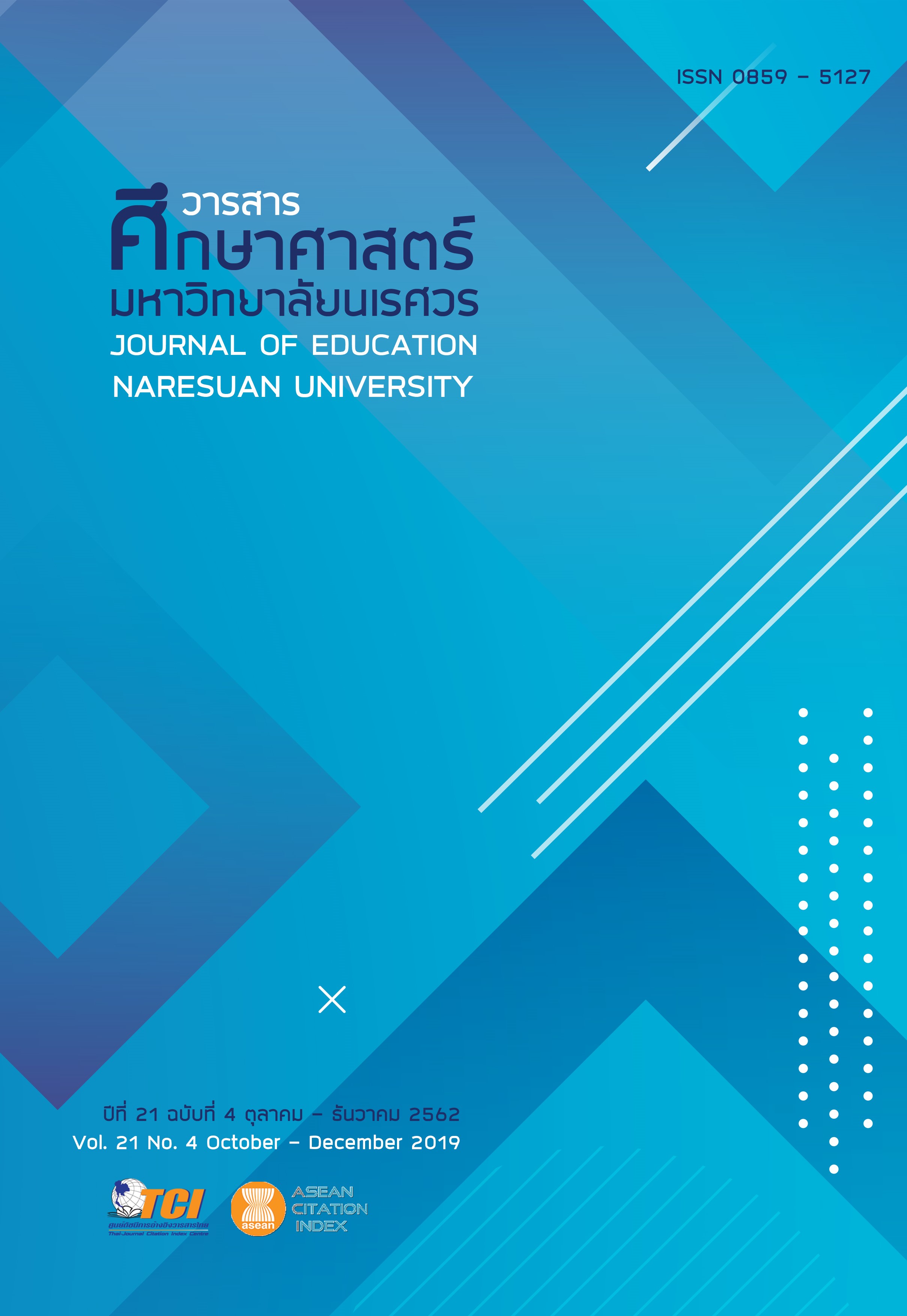การพัฒนาหลักสูตรประวัติศาสตร์ท้องถิ่นตามแนวคิดการศึกษาอิงถิ่นฐาน สำหรับนักเรียนระดับประถมศึกษา: กรณีชุมชนลุ่มแม่น้ำเจ้าพระยาตอนบน จังหวัดนครสวรรค์ (A DEVELOPMENT OF LOCAL HISTORY CURRICULUM BASED ON PLACE-BASED EDUCATION APPROACH FOR PRIMARY SCHOOL STUDENTS: A CASE OF AN UPPER CHAO PHRAYA RIVER COMMUNITY, NAKHON SAWAN PROVINCE)
Main Article Content
Abstract
การวิจัยนี้มีวัตถุประสงค์เพื่อพัฒนาหลักสูตรประวัติศาสตร์ท้องถิ่นตามแนวคิดการศึกษาอิงถิ่นฐานสำหรับนักเรียนระดับประถมศึกษา: กรณีชุมชนลุ่มแม่น้ำเจ้าพระยาตอนบน จังหวัดนครสวรรค์ วิธีดำเนินการวิจัยใช้กระบวนการวิจัยและพัฒนา ประกอบด้วย ขั้นตอนที่ 1 ศึกษาองค์ความรู้ด้านประวัติศาสตร์ท้องถิ่น โดยวิธีการสัมภาษณ์เชิงลึกจากผู้ทรงคุณวุฒิและผู้รู้ในท้องถิ่นเกี่ยวกับประวัติศาสตร์ท้องถิ่นและบริบทท้องถิ่น และศึกษาแนวคิดเกี่ยวกับการพัฒนาหลักสูตรและการจัดการเรียนการสอนประวัติศาสตร์ท้องถิ่นในระดับการศึกษาขั้นพื้นฐาน เพื่อนำมากำหนดเป็นขอบข่ายและลำดับประสบการณ์การเรียนรู้ประวัติศาสตร์ท้องถิ่น ขั้นตอนที่ 2 การสร้างและตรวจสอบคุณภาพหลักสูตร ผลการวิจัย พบว่า
1. ผลการศึกษาองค์ความรู้ด้านประวัติศาสตร์ท้องถิ่นและแนวคิดเกี่ยวกับการพัฒนาหลักสูตรและการจัดการเรียนการสอนประวัติศาสตร์ท้องถิ่นในระดับการศึกษาขั้นพื้นฐาน พบว่า
1.1 องค์ความรู้ประวัติศาสตร์ท้องถิ่น ประกอบด้วยเรื่องราวและความเป็นมาของประวัติศาสตร์ท้องถิ่นชุมชนลุ่มแม่น้ำเจ้าพระยาตอนบน เขตจังหวัดนครสวรรค์ ความสัมพันธ์กับเรื่องเล่า นิทาน ตำนาน คติชน ภูมินาม และวิถีการดำรงชีวิตของคนในท้องถิ่น ความสัมพันธ์กับสิ่งแวดล้อมทางธรรมชาติ
1.2 แนวคิดการพัฒนาหลักสูตรและการจัดการเรียนการสอนประวัติศาสตร์ท้องถิ่นในระดับการศึกษาขั้นพื้นฐาน พบว่า ผู้เรียนควรได้เรียนรู้เรื่องราวประวัติศาสตร์ที่มีความหมายและเริ่มต้นจากบริบทถิ่นฐานบ้านเกิดของตนเอง แนวการจัดขอบข่ายและลำดับประสบการณ์การเรียนรู้สามารถดำเนินการได้ 3 แนวทาง คือ การจัดเนื้อหาแบบตามลำดับเวลา การจัดเนื้อหาแบบกำหนดหัวข้อหรือประเด็น และการจัดเนื้อหาแบบวงกลม
2. ผลการสร้างและตรวจสอบคุณภาพหลักสูตร พบว่า หลักสูตรประกอบด้วย 2 ส่วน คือ หลักสูตรและเอกสารประกอบหลักสูตร หลักสูตรมีองค์ประกอบ ได้แก่ ความสำคัญและความจำเป็น หลักการ จุดมุ่งหมาย คำอธิบายรายวิชา โครงสร้างหลักสูตรและสาระการเรียนรู้ แนวการจัดกิจกรรมการเรียนรู้ แนวทางการวัดและประเมินผล และสื่อการเรียนรู้และแหล่งเรียนรู้ และเอกสารประกอบหลักสูตร ได้แก่ หลักสูตรประวัติศาสตร์ท้องถิ่นตามแนวคิดการศึกษาอิงถิ่นฐานสำหรับนักเรียนระดับชั้นประถมศึกษาปีที่ 6 และ คู่มือการใช้หลักสูตร แล้วนำหลักสูตรและเอกสารประกอบหลักสูตรให้ผู้เชี่ยวชาญประเมินความเหมาะสม พบว่า องค์ประกอบหลักสูตรในภาพรวมอยู่ในระดับเหมาะสมมาก ( = 4.47) และเอกสารประกอบหลักสูตรในภาพรวมอยู่ในระดับเหมาะสมมากที่สุด (
= 4.50) ตามลำดับ ผลการทดลองนำร่องหลักสูตร พบว่า หลักสูตรมีความเป็นไปได้ในการนำไปปฏิบัติจริง
A DEVELOPMENT OF LOCAL HISTORY CURRICULUM BASED ON PLACE-BASED EDUCATION APPROACH FOR PRIMARY SCHOOL STUDENTS: A CASE OF AN UPPER CHAO PHRAYA RIVER COMMUNITY, NAKHON SAWAN PROVINCE
The research objective was to develop local history curriculum based on place-based education approach for primary school students: a case of an upper Chao Phraya River community, Nakhon Sawan province. The research and development (R & D) process model has been adopted to use in the study as follows: step 1 studying local historical narratives, local community contexts and curriculum approach for local history teaching and learning in basic education level in order to define the scope and sequence of local history curriculum in which the data collected from experts by using in-depth interviews, step 2 constructing curriculum and verifying curriculum quality. The results at each step were presented as follows:
1. The local historical narratives, local community contexts and curriculum approach for local history teaching and learning in basic education level were found that:
1.1 The local historical narratives consisted of the narratives of local history in the area of upper Chao Phraya River community, Nakhon Sawan, the relationship between narratives, tales, chronicles, folktales, local-historical name of places, and folkways of local people and the relationship between people and natural environments.
1.2 The curriculum approach for local history teaching and learning in basic education level was as follows: students should learn historical contents which are culturally relevant and start from students’ own community contexts and the scope and sequence of local history curriculum can be designed in 3 approaches: chronological, thematic, and concentric approaches.
2. Curriculum consisted of 2 parts: 1) curriculum documents and 2) supplementary documents. Curriculum documents consisted of rationale, principles, objectives, course description, course structure and learning contents, learning activities, measurement and evaluation, and learning materials and resources. Supplementary documents consisted of local history curriculum based on place-based education approach for grade 6 students and curriculum handbook. The curriculum was evaluated for the appropriateness.The curriculum documents and the supplementary documents were appropriated at high level ( = 4.47) and the highest level (
= 4.50) respectively. The curriculum was then piloted for the further improvement. Its result was at high level of appropriateness and ready for the implementation.
Article Details
The owner of the article does not copy or violate any of its copyright. If any copyright infringement occurs or prosecution, in any case, the Editorial Board is not involved in all the rights to the owner of the article to be performed.
References
2. Cornbleth, C. (1990). Curriculum in context. London: Falmer Press.
3. Danker, A. C. (2003). Multicultural Social Studies: The local history connection. The Social Studies, 94(2), 111-117.
4. Kesmanee, C., & Charoensri, K. (2006). A synthesis of research report: The research project on central region local history. Bangkok: Thailand Research Funds. [in Thai]
5. National Council for the Social Studies (NCSS). (2010). Expectations of excellence: Curriculum standards for social studies. Silver Springs, MD. Retrieved December 10, 2010, from http://www.socialstudies.org/standards/foreword
6. Ornstein, A. C., & Hunkins, F. P. (2008). Curriculum: Foundations, principles and issues (5th ed.). Boston: Allyn and Bacon.
7. Pilanthananond, N. (2003). From curriculum to learning unit. Bangkok: Thaiwattanapanich. [in Thai]
8. Rittidet, P. (2011). Local youth historical research for students based learning reform, northeast Thailand. Journal of social sciences, 7(2), 224-227.
9. Sasiwongsaroj, K. (2013). The central region amid a wave of changes: A synthesis of research projects on local history of the central region by youth historians. Journal of Humanities and Social Sciences, Khon Kaen University, 30(2), 107–132. [in Thai]
10. Sattayanurak, A. (2005). History for community: New directions of local history education. Bangkok: Thailand Research Funds. [in Thai]
11. Suebwattana, T. (2011). Principles and approaches for local history education. Bangkok: Inthanin Publishing. [in Thai]
12. Thongthew, S. (2008). Evolution of curriculum theory and frameworks for developing alternative curriculum innovation. Journal of Education, Naresuan University, 10(3), 91-124. [in Thai]
13. Wallipodom, S. (2011). Development of Thai culture and society. Bangkok: Muangboran. [in Thai]
14. Wattanatorn, A., & Thongthew, S. (2007). The development of Bann Thawai’s mediated economics curriculum for sustainable wood-carved business. Journal of Population and Social Studies, 16(1), 105-116.


